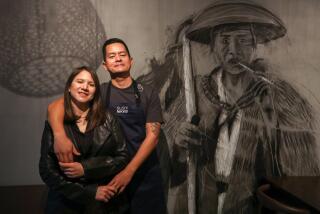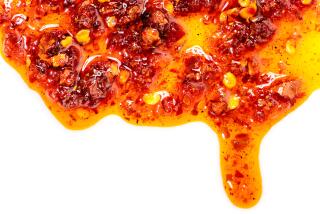Kimchi: This Pickle Bites Back : Preparation: It began about 2,000 years ago as a way of preserving crops. Today it is an important food for many Angelenos.
- Share via
In a small, spotless room in a factory in Vernon, workers clad in brilliant yellow aprons and orange gloves are making kimchi. Except for a small home-style blender used to grind garlic and ginger, the work is done by hand. Huge bowlfuls of greens are tossed with seasonings as if they were enormous salads. A few workers punch cabbages down into jars, adding plenty of powerfully spicy chile sauce.
Here at Terok Trading Corp., an importer of Asian food and food-related products that runs one of Los Angeles’ several kimchi factories, 10 kinds of kimchi are made. The vegetables used include napa cabbage, white radishes, mustard greens, turnip greens, green onions and leeks.
The procedure for cabbage kimchi, the most common variety, is to soak the vegetables in salty water for a day, wash out the salt in several changes of water, then add the seasonings and bottle the mixture.
Kimchi is strong stuff indeed. The pickled cabbage and/or other vegetables are brought to an incendiary level with red pepper and heavy doses of garlic.
Also in the Terok mix is Hasunjung-brand anchovy sauce. It’s a condition the company agreed to in order to acquire the license to use the name Hasunjung, which has a strong identity for Koreans because it is a leading brand of kimchi in Korea. (The name appears on the label in Korean only.)
The Koreans came up with kimchi as a way of preserving crops for winter eating some 2,000 years ago. It’s a relative newcomer to Los Angeles, but kimchi stands to become as integral a part of the local cuisine as Mexican salsa. Not only do the 600,000 Koreans who live here consume vast quantities of it, but many non-Asians like it too.
Most non-Asians first encounter kimchi in a Korean restaurant, where one or more varieties automatically accompany a barbecue dinner. The more adventuresome may move on to such spicy dishes as kimchi casserole and kimchi soup. And the true devotee will wind up experimenting with the many kimchis offered in awesome displays in local Korean markets.
“Once you have acquired a taste for it, your dinner table will never be complete without it,” write Florence C. Lee and Helen C. Lee in their cookbook, “Kimchi, a Natural Health Food” (Hollym: $9.95). The Lees offer recipes for 48 of the more than 200 types of kimchi that are said to exist.
Those who don’t have time to make their own kimchi buy it in supermarkets. At the California Market on Western Avenue in Koreatown you can take your pick of kimchis made with cabbage, cucumber, white radish, radish with tops, young radish, leek, mustard and mustard greens. Most of the jars are red with chile, but there is also mild, white kimchi for tender palates. The jars range in size from 7-pound 14-ounce whoppers to modest 1-pound containers. Plastic sacks of unlabeled bulk kimchi are also on hand.
Major chains are also carrying kimchi. All Ralphs markets are authorized to stock kimchi, according to Ken Hanshaw, vice president dairy/deli for Ralphs Grocery Co. The Ralphs at Third Street and Vermont Avenue, near Koreatown, offers four brands, as does Vons on the opposite corner.
Terok’s Hasunjung brand of kimchi is allowed to sit on market shelves just one week. Any unsold jars are returned to the factory. At home, kimchi can be stored in the refrigerator for up to one month. After that, says Michael Lee, Terok vice president, the flavor deteriorates.
In a Korean household, kimchi is not likely to last that long. It’s eaten at every meal, either as a relish or as part of a more substantial dish. “Kimchi is a main food for Koreans,” Lee says, “like bread for Americans.”
More to Read
Eat your way across L.A.
Get our weekly Tasting Notes newsletter for reviews, news and more.
You may occasionally receive promotional content from the Los Angeles Times.










